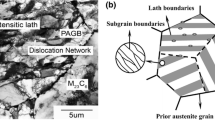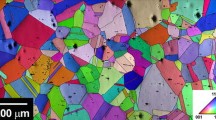Abstract
The effect of phase continuity on the low cycle fatigue and fatigue crack growth behavior of a Fe-C-Mn dual-phase steel has been investigated. Two microstructures, one consisting of continuous ferrite and the other continuous martensite, were examined. Although there was no difference in the low cycle fatigue lives between the two microstructures, the continuous martensite structure exhibited an extremely high fatigue threshold value of 20 MPa m1/2, compared to 16 MPa m1/2 for the continuous ferrite microstructure. A major effect of phase continuity has also been found in the crack closure levels during fatigue crack propagation studied over three decades of crack growth rates. The continuous martensite microstructure exhibited much higher closure levels due to the martensite constraining the plastic deformation in the ferrite and bearing a larger portion of the applied cyclic load. This effect is similar to the extrinsic toughening phenomenon cited in the literature. After accounting for the closure levels the intrinsic or effective fatigue crack growth rates are similar for the two microstructures. These intrinsic thresholds are predicted by employing experimentally obtained low cycle fatigue parameters and the ferrite grain size.
Similar content being viewed by others
References
H. Suzuki and A. J. McEvily:Metall. Trans. A, 1979, vol 10A pp. 475–81.
K. Minakawa, Y. Matsuo, and A. J. McEvily:Metall. Trans. A, 1982, vol. 13A, pp. 439–45.
J. A. Wasynczuk, R. O. Ritchie, and G. Thomas:Mat. Sci. & Eng, 1984, vol. 62, pp. 79–92.
V. B. Dutta, S. Suresh, and R. O. Ritchie:Metall. Trans. A, 1984 vol. 15A, pp. 1193–1207.
N. J. Kim and G. Thomas:Metall. Trans. A, 1981, vol 12A pp. 483–89.
T. Ishihara:J. of Mat. Sci., 1983, vol. 18, pp. 103–08.
J. D. Lavender and F. W. Jones:JISI, September 1949, pp. 14–17.
M. Hillert and L.-I. Staffanson:Acta Chem. Scand., 1970, vol. 24 pp. 3618–26.
R. O. Ritchie:International Metals Review, 1979, vol 24 pp. 205–30.
D. Bryant:Micron and Microscopica Acta, 1986, vol. 17, pp. 237–41.
S. Suresh:Metall. Trans. A, 1983, vol. 14A, pp. 2375–85.
G. Birkbeck, E. A. Inckle, and G. W. J. Waldron:J. Mat. Sci., 1971, vol. 6, pp. 319–23.
C. J. Beevers:Fatigue Thresholds, J. Backlund, A. F. Blom, and C.J. Beevers, eds., EMAS Ltd., Warley, U.K., 1982, vol. 1, pp. 257–69.
R. O. Ritchie and W. Yu:Small Fatigue Cracks, R. O. Ritchie and J. Lankford, eds., AIME, 1986, pp. 167–89.
K. Minakawa and A. J. McEvily:Scripta Metall., 1981, vol. 15, pp. 633–36.
R. D. Carter, E. W. Lee, E. A. Starke, Jr., and C. J. Beevers:Metall. Trans. A, 1984, vol. 15A, pp. 555–63.
K. V. Jata and E. A. Starke, Jr.:Metall. Trans. A, 1986, vol. 17A, pp. 1011–26.
G. T. Gray, III, J. C. Williams, and A. W. Thompson:Metall. Trans. A, 1983, vol. 14A, pp. 421–33.
C. Y. Yang and H. W. Liu:Fatigue Eng. Mat. and Struc, 1979, vol. 1, pp. 483–93.
S. B. Chakrabortty:Fatigue Eng. Mat. and Struc., 1979, vol. 2, pp. 331–44.
H. C. Heikkenen, E. A. Starke, Jr., and S. B. Chakrabortty:Scripta Metall., 1982, vol. 16, pp. 571–74.
E. A. Starke, Jr., F. S. Lin, R. T. Chen, and H. C. Heikkenen:Fatigue Crack Growth Threshold Concepts, D. L. Davidson and S. Suresh, eds., TMS-AIME, Warrendale, PA, 1984, pp. 43–61.
S. Majumdar and J. Morrow:Fracture Toughness and Slow-Stable Cracking, ASTM STP 559, Philadelphia, PA, pp. 159–63.
R. E. Sanders and E. A. Starke, Jr.:Thermomechanical Processing of Aluminum Alloys, J. G. Morris, ed., TMS-AIME, Warrendale, PA, 1979, pp. 50–73.
Author information
Authors and Affiliations
Rights and permissions
About this article
Cite this article
Ramage, R.M., Jata, K.V., Shiflet, G.J. et al. The effect of phase continuity on the fatigue and crack closure behavior of a dual-phase steel. Metall Trans A 18, 1291–1298 (1987). https://doi.org/10.1007/BF02647198
Received:
Published:
Issue Date:
DOI: https://doi.org/10.1007/BF02647198




